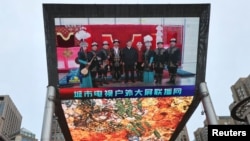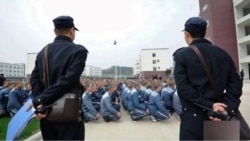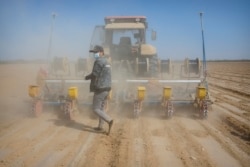On August 16, an independent expert appointed by the U.N. Human Rights Council released a report saying it was “reasonable to conclude” that Uyghurs and other ethnic minorities in China’s northwestern Xinjiang region are being subjected to forced labor.
While the report acknowledges that China’s work programs “may create employment opportunities for minorities and enhance their incomes,” it also notes the “involuntary nature” of the labor in many cases.
Workers, it says, are subjected to “excessive surveillance, abusive living and working conditions, restriction of movement through internment, threats, physical and/or sexual violence and other inhuman or degrading treatment.” Such treatment may constitute “enslavement as a crime against humanity,” the report states.
Beijing reportedly tried to halt the release of the report, and Foreign Ministry Spokesperson Wang Wenbin denounced it on August 17.
“[A] certain special rapporteur chooses to believe in lies and disinformation about Xinjiang spread by the U.S. and some other Western countries and anti-China forces, abuse his authority,” Wang said, referring to Tomoya Obokata, the U.N. Special Rapporteur on Contemporary Forms of Slavery.
Wang accused Obokata of “denigrating” China and serving “as a political tool for anti-China forces.”
“There has never been 'forced labor’ in Xinjiang,” Wang said. “The Chinese government follows a people-centered development philosophy and attaches great importance to protecting the rights and interests of workers.”
That is false.
The U.N. report drew on a growing body of independent academic research, open sources, victim testimony and government accounts to reach its conclusions about forced labor in Xinjiang, where more than 1 million people have been interned.
Still, providing an accurate account of what is going on in Xinjiang is not easy.
China’s restricted media environment and limited access in Xinjiang greatly complicate verification efforts.
The U.S.-based Workers Rights Consortium said that “extreme levels of repression and surveillance” in Xinjiang stop brands and retailers from using labor rights audits “to ensure that their supply chains are free from forced labor.”
China does not provide unfettered access to outside observers seeking to investigate abuse claims in Xinjiang.
Outgoing U.N. human rights chief Michelle Bachelet visited Xinjiang in May and said she “was not able to speak to any Uyghurs currently detained or their families during the visit.” She also said she “was accompanied by government officials throughout the visit to Xinjiang.”
Still, China used that controversial trip, which Bachelet explicitly stated “was not an investigation,” to exonerate itself of genocide charges.
In reaction to Bachelet’s trip, 39 scholars of the Uyghur region argued in an open letter published in June that “China is committing crimes against humanity at a scale that extends far beyond the mass internment program.”
The letter’s signatories said many of the internment and indoctrination camps had recently closed, adding that “a substantial portion of internees from now-closed camps have been transferred to formal prisons after sham trials, while others have been placed in forced labor programs.”
The scholars added that the abundant evidence of “atrocities in Xinjiang” had led them to an “extraordinary consensus” rarely seen in the academic field.
The U.N. report said China’s “forced labor scheme” includes a vocational skills education and training center system, under which “minorities are detained and subjected to work placements.”
China claims the system is used to “eliminate sources of terrorism.”
The U.N. report cites groups and researchers who have come under attack from Beijing for alleged bias, including Adrian Zenz, a researcher at the Washington-based Victims of Communism Memorial Foundation, who has written extensively about China’s Uyghurs. China accuses Zenz of being “a right-wing Christian” looking to slander the Chinese Communist Party.
In June, Zenz wrote a report titled “Unemployment Monitoring and Early Warning: New Trends in Xinjiang’s Coercive Labor Placement Systems.”
The report, drawing on Chinese planning documents and other internal Chinese Communist Party sources, found that “Xinjiang’s labor transfers became highly coercive” at the same time as the mass internment program for Uyghurs began in 2017.
In 2018, The New York Times reported that “mounting evidence suggests a system of forced labor is emerging from the camps.”
The evidence included accounts from the regions, satellite images and official documents showing that more and more detainees were “being sent to new factories, built inside or near the camps,” with “little choice but to accept jobs and follow orders.”
Investigative reports by other media outlets have reached similar conclusions.
New York-based Human Rights Watch said the crackdown in Xinjiang corresponded to the relocation of textile and garment factories to the region, “hinting at a textile and apparel expansion plan that depends heavily on the forced labor of inmates at the various detention facilities.”
China is a global leader in cotton production, and Xinjiang supplies roughly 85% of the country’s cotton.
Some Uyghur advocacy groups have described Xinjiang as the “cotton gulag.”
In October 2019, the U.S.-based Uyghur Human Rights Project (also cited in the U.N. report) and 36 other human rights organizations called for a ban on cotton, textiles and other apparel products exported from Xinjiang.
Their joint letter cited a report by the Washington, D.C.-based Citizen Power Initiatives for China, which drew on Chinese government and company data, as well as witness testimony. The letter stated that “China, the world’s largest cotton producer, has built the world’s largest forced labor system to provide the workers needed to sustain its cotton production.”
A December 2020 BBC report found that hundreds of thousands of Uyghurs and members of other ethnic minorities were being forced to pick cotton in Xinjiang.
The BBC report cited Zenz, who uncovered the documents revealing the “potential scale of forced labor” in China’s cotton-picking industry. It also documented efforts by Chinese authorities to restrict access to BBC journalists attempting to work in Xinjiang.
China dismissed those forced labor accusations as completely fabricated.
Researchers have uncovered similar evidence implicating China’s solar power industry.
Zenz has also worked with the Xinjiang Papers, a cache of government documents outlining China’s policies in the region. The documents were first reported on by The New York Times in November 2019 and leaked in full to the London-based Uyghur Tribunal in September 2021.
The Uyghurs Tribunal, an independent people’s tribunal tasked with investigating ongoing atrocities in Xinjiang, asked Zenz to authenticate the documents. The tribunal was also cited in the U.N. report.
Zenz found “substantial evidence linking numerous aspects of Beijing’s crackdown in Xinjiang.” That evidence includes "explicit statements and demands made by central government figures,” along with “mass internments in re-education camps and poverty alleviation through coercive labor transfers.”
Chinese officials have dismissed the Xinjiang Papers as a “fabrication,” but Western academics tasked with authenticating the documents found them to be genuine.
The second state-mandated system noted in the U.N. report is the labor transfer system, under which “surplus rural laborers are transferred into secondary or tertiary sector work.”
In a March 2020 report, the Australian Strategic Policy Institute (ASPI) estimated that “more than 80,000 Uyghurs were transferred out of Xinjiang to work in factories across China between 2017 and 2019,” in a program called “Xinjiang Aid.”
Using “open-source Chinese-language documents, satellite imagery analysis, academic research and on-the-ground media reporting,” ASPI said it had identified “27 factories in nine Chinese provinces that are using Uyghur labor” that is unlikely voluntary.
A study released in May 2021 by the Helena Kennedy Center for International Justice at Britain’s Sheffield Hallam University focused on forced labor in the solar energy industry.
The study concluded that “significant evidence – largely drawn from government and corporate sources – reveals that labor transfers are deployed in the Uyghur Region within an environment of unprecedented coercion."
The study noted that an official Chinese government document from November 2020 recorded “the ‘placement’ of 2.6 million minoritized citizens in jobs at farms and factories within the Uyghur Region and across the country through these state-sponsored ‘surplus labor’ and ‘labor transfer’ initiatives.”
In June, the U.S. government began to implement the Uyghur Forced Labor Prevention Act, which requires importers to prove any goods made completely or in part in Xinjiang were “not produced using forced labor” before entering the United States.







